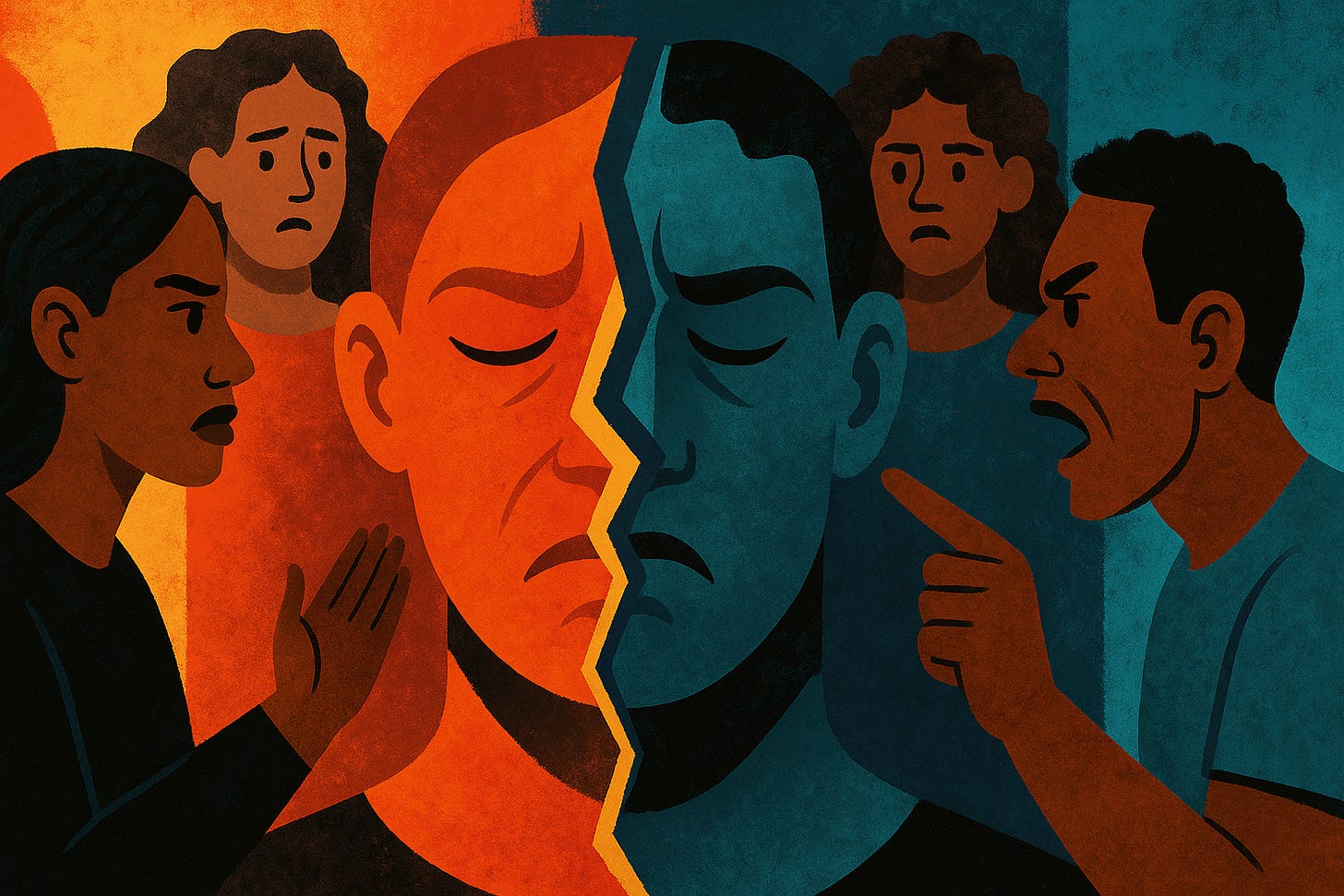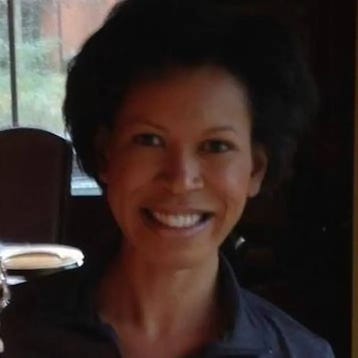✍🏾In Her Words: Who Is the Aggressor? Misogyny, Misandry, and the Reversal of Reality.
Guest Contribution by Jocelyn Crawley
The Peachy Perspective occasionally features guest posts from Southern radical feminists whose voices sharpen our collective fight for women’s liberation. This In Her Words entry brings you more from Jocelyn Crawley, a radical feminist in Atlanta, Georgia. Her latest contribution examines how patriarchal reversals shape the false equivalence between misogyny and misandry—showing that woman-hating, not man-hating, remains the driving force of male supremacy.
Although radical feminists face many challenges in attempting to undermine and abrade patriarchy, one of the most difficult experiences for many of us is convincing non-radical feminists to grasp that our worldview is not a perspective; rather, it is grounded in material realities which transpire on a landscape in which men exist as the dominant, master class while women only operate as the subordinated slaves. This master/slave dichotomy unfolds in a plethora of ways, but each manifestation reinforces our understanding that men have more social, economic, and political power than us while also providing us with a framework through which to grasp that much of this power is actualized for nefarious purposes. Additionally, the presence of the master/slave binary enables us to grasp that, because men have more agentive authority than women, the harm women experience as a result of male malevolence in their lives has a more deleterious impact on them than the hurts men endure as an outcome of women entering their psychosocial and spatial domains with malicious intent leave them with. Put simply, misogyny is more harmful than misandry.
Although the juxtaposition of misogyny and misandry might seem to be a reality which would engender clear, incontrovertible conclusions regarding the reality that men are a greater threat to the livelihood and well-being of women than female people are to males, this remains a contentious claim in mainstream circles. (For this reason, it is normative to hear the potentially problematic relationships between men and women framed as “the battle between the sexes,” with this frame suggesting that male and female people are both actively and equally at war with one another. This frame is fundamentally false but the linguistic framing continues.) Amongst radicals, however, there seems to be collective agreement that while there are a few women who actively and accurately identify as man-haters while many others secretly harbor fleeting feelings of antipathy towards men without regularly and unabashedly expressing them, the female identifications and emotive dispositions towards men typically do not translate into the forms of violence (including but not limited to rape, murder, torture, and bodily mutation) that male people demonstrate towards female beings. This is the understanding which precipitates assent to the idea that man-hating, while problematic, is not as significantly problematic as woman-hating. Yet many people insist otherwise.
Joanna Russ doesn’t. In fact, in her own important essay “The New Misandry,” she conveys her awareness that misogyny is substantively worse than misandry through the effective deployment of irony. Specifically, she writes:
Perhaps the most important cause of fear of misandry is the awfulness of facing t the extent to which misandry and misogyny are an inescapable part of the texture of our lives. It is all right to joke about “the battle of the sexes” but we must not take it seriously for the paradoxical reason that it is too seriously — every man is a misogynist, how can he help it? and very woman is a misandrist, how can she help it? The misandry, of course, is far worse than the misogyny — thus giving us a clue as to who the aggressor is in the “battle.”
Here, Russ deploys irony to convey that misogyny is worse than misandry with language that suggests the opposite: “The misandry, of course, is far worse than the misogyny.” Perhaps her sarcastic use of the phrase “of course” gives the intent of the sentence away but, if one doesn’t understand Russ’s purpose with this utterance alone, her encapsulation of the word battle with quotation marks makes the meaning she is making plain. Within a non-feminist, patriarchal, and/or woman-hating framework, the aggressor in the “battle” between men and women is women–this is the case because, in a woman-hating society–female people must be viewed as the problem-creators, not the victims of problems created by men. The tell-tale quotation marks that surround the word battle are telling a tale that radical feminists have repeatedly recognized: no matter how women try to ground their understanding of male violence and hatred in terms of a horrific war that female people constantly lose as a result of male aggression, the narratives of male supremacy can continually reconstruct reality such that women are aggravating aggressors who problematize male safety and security.
What becomes evident upon examination of Russ’s deployment of rhetorical strategies such as irony to convey the reality of misogyny–not misandry–generating more harm is that counternarratives exist. As many of us know, master narratives involve a dominant class of people (in our case, men) maintaining control of how reality is defined in language so that this fallacious and fragmented understanding of experiences and events is accepted by everyone–both the masters (men) and slaves (women). The counternarrative that is contextual to the master narrative is that no, the misandry is not worse than the misogyny. In reality, the deleterious impact that men have on women through the practice of misogyny is much more profound than acts of ostensible man-hating have on men. This reality becomes glaringly evident with an even cursory juxtaposition of male violence against women versus female violence against men, so I will not engage in an exhaustive enumeration of the historical and modern day impact of misogyny here. However, I do want to offer up the reality of rape as a particularly effective example through which to understand the absurdity of asserting that men experience more harm at the hands of women than women experience as a result of interacting with males.
Although defined diversely and divergently, rape is generally defined as nonconsensual intercourse which involves one person placing their genitals into the genitals of another person without their permission. In cases of men raping women, this would involve a man voluntarily and intentionally placing his penis in the vagina of a woman without her expressing desire or willingness for him to do so. Empirical data reveals that it is much more common for a male to rape a woman than it is for a woman to sexually assault a man. Additionally, research indicates that rape has a profoundly negative impact on women. Specifically, sexual assault can engender long-term psychological and somatic changes as a result of the activation of stress responses in the body. The biological changes generated by assaults can catalyze a plethora of health issues as time passes, including but not limited to gastrointestinal issues, chronic pain, and sexual dysfunction. Given that it is more common for men to rape women than for women to rape men, it follows that the collective impact of sexual assault on female people is substantively greater than the impact of females raping males on men. (This principle holds true for gender-related murders as well. It is more common for men to murder women than it is for women to murder men. When women and girls are murdered by men specifically because they are female, the term femicide is applied. Whether they are femicides or not, it is safe to say that the murder of women by men has a more saliently and substantive collective impact than that of women murdering men.)
As indicated in the previous paragraph, male violence against women is more prevalent than female violence against men, and this reality becomes evident when one considers the social phenomenon of rape. To assert that misogyny (woman-hating) is less substantively harmful than misandry (men-hating) in light of our awareness of phenomena such as rape is, in my opinion, the process of committing the crime of promoting a patriarchal reversal. Rape is but one–but an important one–example of how a patriarchal reversal becomes evident. My understanding of patriarchal reversals is that the definition involves men asserting that women are culpable for a problematic and potentially nefarious action or attitude when, in reality, male people carry the weight of culpability for the actions and attitudes in question. In the context of rape, it is almost always men that are psychosomatically harming women through unwanted “sexual” contact. It is not primarily women who bring men into positions of humiliation, pain, anxiety, and other forms of harm associated with rape. Therefore, when people (oftentimes men) assert that women cause more harm to men rather than the inverse, a patriarchal reversal has become operative. Men are causing the most harm of either gender, and the harm is projected towards women at alarming rates and in alarming ways. We need to understand this. We need to know that a plethora of fallacious arguments (including the one articulated here regarding misogyny and misandry) are regularly being submitted into the realm of public discourse in ways that obscure the nature of relations and relationships with men and women. We need to understand that the dissemination of these fallacious concepts is problematic not only because of their inaccuracy, but because of the role that they play in giving women a false sense of safety around men while also obscuring their ability to understand the depth and scope of male deleteriousness.
In conclusion, the reality of rape helps us refute the patriarchal reversal of claiming that, within the system of gender relations where hatred towards one sex by another transpires regularly, misandry has a more egregious impact than misogyny. The ongoing refutation of this and other patriarchal reversals is important because it creates the conditions confluent with accurately understanding the nature of gender relations and subsequently determining how one wants to respond to the necrotic, nefarious realities that male supremacy presents women with on a daily basis.





Well said! Thank you for your contribution, Jocelyn!